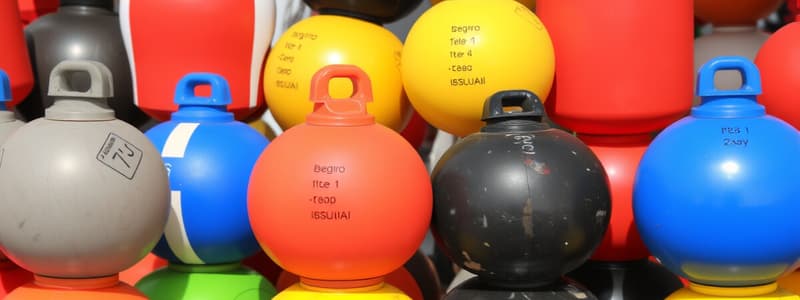Podcast
Questions and Answers
What color is the buoy that indicates 'Away from open water'?
What color is the buoy that indicates 'Away from open water'?
- Blue
- Red (correct)
- Green
- Yellow
What color is the buoy that indicates 'Towards open water'?
What color is the buoy that indicates 'Towards open water'?
- Red
- Green (correct)
- White
- Black
What happens to numbers as you head from open water?
What happens to numbers as you head from open water?
Increase
What happens to numbers as you head towards open waters?
What happens to numbers as you head towards open waters?
What are junction buoys used for?
What are junction buoys used for?
What color are Can buoys?
What color are Can buoys?
What color are Nun buoys?
What color are Nun buoys?
What do the numbers under daymarkers (buoys) indicate?
What do the numbers under daymarkers (buoys) indicate?
What does a square non-lateral marker provide?
What does a square non-lateral marker provide?
What does a diamond non-lateral marker warn of?
What does a diamond non-lateral marker warn of?
What area does a circle non-lateral marker mark?
What area does a circle non-lateral marker mark?
What does a crossed diamond marker represent?
What does a crossed diamond marker represent?
What does a safe water marker indicate?
What does a safe water marker indicate?
What color are mooring buoys?
What color are mooring buoys?
What does an inland waters obstruction marker look like?
What does an inland waters obstruction marker look like?
What type of anchor is good for most boats and uses holding power by plowing into the bottom?
What type of anchor is good for most boats and uses holding power by plowing into the bottom?
What type of anchor is lightweight and digs into bottom sediment?
What type of anchor is lightweight and digs into bottom sediment?
What should you not use a mushroom anchor for?
What should you not use a mushroom anchor for?
How much chain should be added to the anchor?
How much chain should be added to the anchor?
What are the first steps to anchor your boat?
What are the first steps to anchor your boat?
What can happen at a low-head dam?
What can happen at a low-head dam?
What is the purpose of locks?
What is the purpose of locks?
What are fenders used for?
What are fenders used for?
What does 'aground' mean?
What does 'aground' mean?
What is the 'Circle of Death' in boating?
What is the 'Circle of Death' in boating?
Where must the registration card be kept?
Where must the registration card be kept?
What is required on the front of the boat?
What is required on the front of the boat?
How long is a boat registration valid for?
How long is a boat registration valid for?
Where can you obtain boat registration?
Where can you obtain boat registration?
It is legal to operate a motorized vessel while under the influence in South Carolina.
It is legal to operate a motorized vessel while under the influence in South Carolina.
What are the potential penalties for operating a vessel under the influence?
What are the potential penalties for operating a vessel under the influence?
What is the penalty for felony BUI?
What is the penalty for felony BUI?
How far should you stay away from a US Navy boat?
How far should you stay away from a US Navy boat?
Kids 12 and younger are not required to wear PFDs in NJ.
Kids 12 and younger are not required to wear PFDs in NJ.
Flashcards are hidden until you start studying
Study Notes
Navigation and Buoys
- Red buoys indicate a safe path away from open water and have even numbers.
- Green buoys signal a route towards open water and are marked with odd numbers.
- As boats head away from open water, buoy numbers increase; numbers decrease when heading towards open water.
- Junction buoys direct vessels at channel splits; green on top indicates the preferred right channel, while red on top indicates the left.
Buoy Colors and Types
- Can buoys are colored green.
- Nun buoys are colored red.
- Daymarker numbers indicate the distance from the river's mouth.
- Non-lateral markers include:
- Square: Provides directions and information.
- Diamond: Warns of hazards and obstructions.
- Circle: Marks controlled areas.
- Crossed diamond: Marks closed areas.
- Safe water markers are white with red stripes, indicating unobstructed waters that can be passed on either side.
- Mooring buoys, white with a blue stripe, are designated for tying up boats in marinas.
- Inland waters obstruction markers are white with black stripes indicating areas to avoid navigating through.
Anchoring Techniques
- Recommended chain length for anchoring is 7-8 feet.
- Proper anchoring procedure includes:
- Selecting a clear area with adequate depth and bottom material.
- Positioning the boat upwind/downcurrent, lowering the anchor over the bow.
- Letting out a significant amount of anchor line based on water depth and conditions.
- Tying the line off securely and checking for anchor drag.
- Using splices over knots whenever possible for better connection strength.
Boat Safety Hazards
- Low-head dams pose significant risks; currents can pull boats toward the dam and create dangerous whirlpools.
- Locks facilitate safe transport between different water levels, functioning similarly to elevators for boats.
- Fenders serve as protective devices between boats and docks, preventing damage.
Legal Requirements and Regulations
- Always have the boat's registration card onboard for inspection.
- Vessel registration number must be:
- Displayed on both sides of the bow, visible from left to right.
- At least three inches high, contrasting with its background.
- Separated by a space or hyphen from the registration letters.
- Registration is valid for three years and can be obtained from designated offices and marine dealers.
Alcohol and Boating Laws
- Operating a motorized vessel under the influence of alcohol or drugs is prohibited; enforcement can lead to severe penalties.
- Penalties may include fines up to $6,000 and imprisonment for up to three years.
- Felony Boating Under the Influence (BUI) can result in fines of up to $25,000 and 25 years in prison.
Safety Practices
- Maintain a safe distance of at least 500 yards from US Navy boats.
- New Jersey law requires children 12 years and younger to wear Personal Floatation Devices (PFDs) while on the water.
Studying That Suits You
Use AI to generate personalized quizzes and flashcards to suit your learning preferences.




